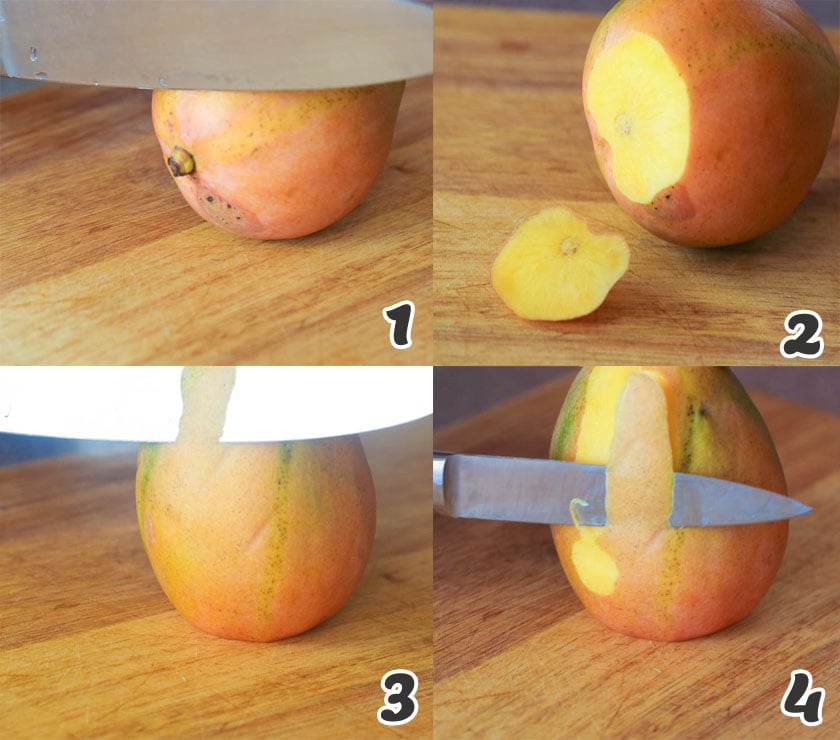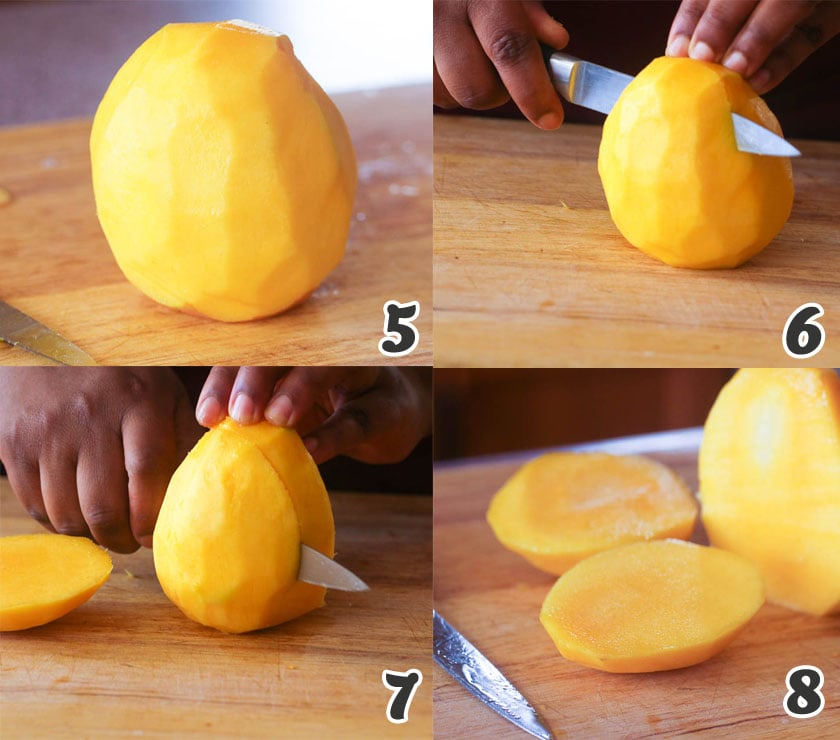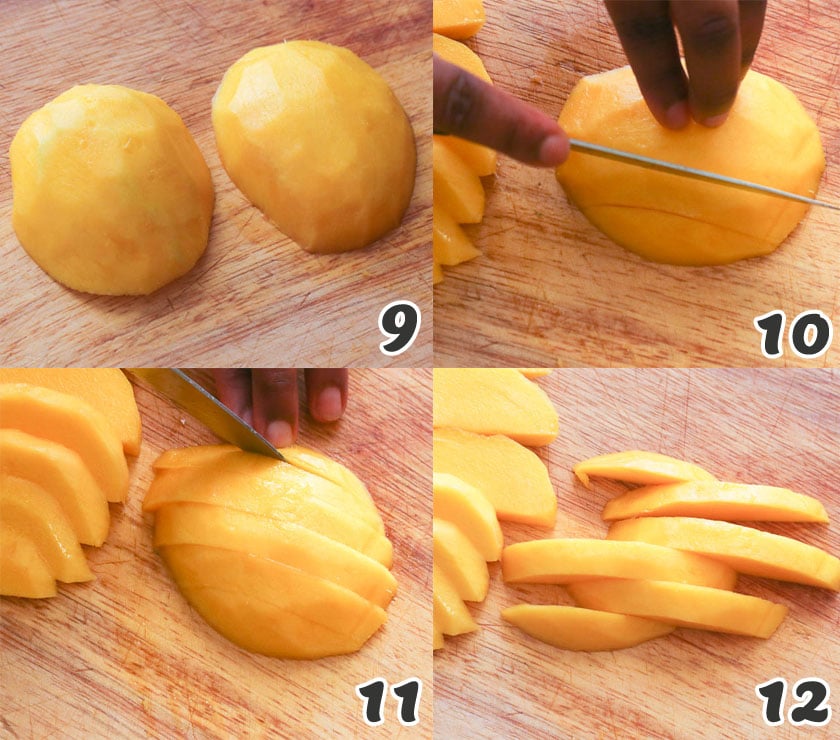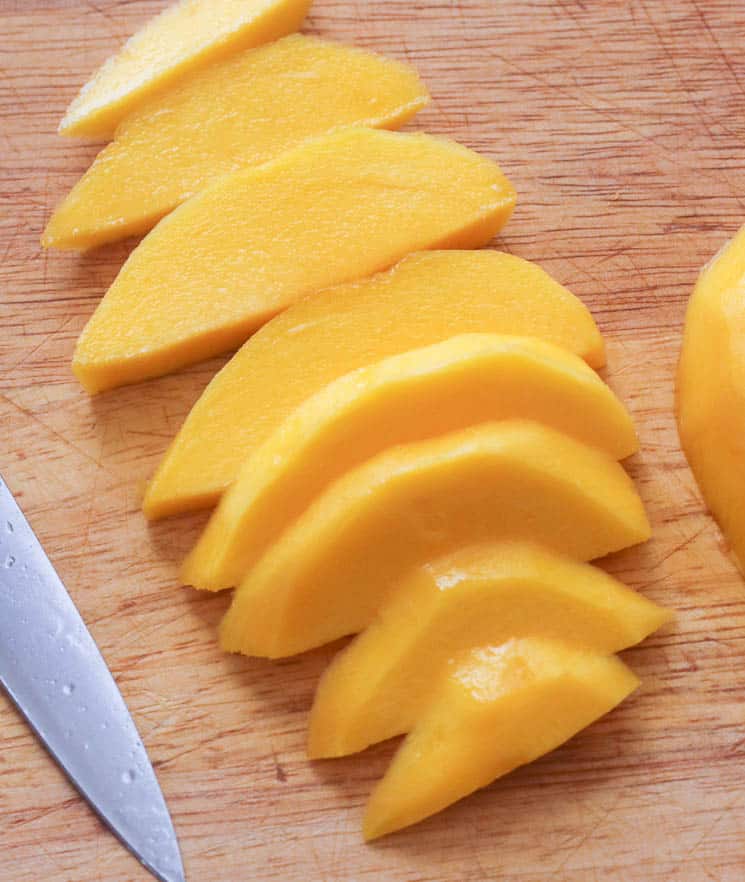Have you ever cut off the biggest, juiciest chunk of mango after spending several painstaking minutes peeling the thing just to have that slippery baby fly out of control and hit the kitchen floor?
Well, no more kitchen tragedies, my friends.
Because in this guide, you’ll learn how to pick out a perfectly ripe mango and cut it up quickly and easily, sans the slippery messes and frustration! 😅
Contents…How to Cut |
How to Cut a Mango
- Hold the mango upright, with the stem side resting on your cutting board. (Photo 1)
- Imagine the oblong, thin pit running down the middle, then cut the mango from the top down just alongside the pit. (Photo 2)
- Then repeat on the other side of the pit. (Photo 3)
- With the leftover middle piece, carefully extract the pit with your knife, and, depending on the size of the mango, you may be able to cut off quite a bit of flesh from around it. (Just don’t forget to remove the peel.)
- For each of the two halves, score the mango’s flesh with your knife, creating long horizontal and vertical lines without cutting the skin. It should look sorta like a grid when you finish. (Photos 4-7)
- Gently flip the peel inside out by pushing upwards with your fingers. The cubes of mango flesh will stick up and become super easy to cut off with your knife. (Photo 8)
Tip: Alternatively, don’t push the peel upwards; instead, take a spoon and scoop out the mango flesh, which will pop out in neat little cubes.
- Peel the mango completely using a sharp kitchen knife. Serrated knives work well for this, as do Y-shaped vegetable peelers.
- Cut a little bit off the bottom of the mango to make a flat area so you can stand the mango upright. (Photos 1-2)
- Cut the mango from top to bottom just alongside the pit on the two thicker sides.
- With these larger pieces, you can cut the mango into slices, cubes, or even dice it into smaller chunks – say, to make mango salsa. 😋
- Carefully remove any remaining flesh from around the pit; just be careful not to cut yourself!
Different Type of Mangos
There are dozens of different kinds of mangos, but there are a few common varieties you’re likely to come across in your local grocery store:
- Tommy Atkins – This variety is super common in the U.S., and its peak season runs from March until July. They can be red, dark green, yellow, or a combination of the three colors. You’ll know they’re ripe by their mouthwatering fragrance and feel.
- Haden – This is the most widely grown mango in the world! It, too, is green, yellow, and red, but unlike the Tommy Atkins, its green patches turn yellow as it ripens, giving you a visual indication that it’s ready to eat. These mangos are most common from March through May.
- Kent – These mangos are large with a dark green color accented by a dark red blush on a small part of the mango. Yellow dots or undertones appear as the mango ripens. They are usually available from December through February.
- Honey (a.k.a. Ataulfo) – With a vibrant yellow color, these mangos are a bit smaller, and the flesh is practically fiber-free. The skin turns a more golden color and wrinkles slightly as they ripen. You can find honey mangos in stores from March to July.
How to Know a Mango is Ripe
As noted above, some kinds of mangos have visual indicators that help you see if the mango is ripe or not, but not all.
Your best bet is to feel and smell a mango to know if it is ready to eat.
A ripe mango should be firm but give just slightly when you give it a gentle squeeze. You can also smell the mango near the stem. Ripe mangos give off that classic tropical aroma.
If the mango is still very hard, you can store it at room temperature until it ripens.
It will be challenging to cut and cube if it gets too soft, so those might be better suited for a mango drink like a mango margarita or a mango lemonade. 🤤
FAQs
Mangos are great for you! Studies suggest that they contain magnesium, potassium, and many other nutrients that can reduce inflammation and stabilize the digestive system.
Spring through early summer is when mangos are most plentiful and at their peak flavor-wise. However, a few varieties can be found earlier, like the Kent mango, which comes into season December through February.
Store uncut, unripe mangos at room temperature until they ripen, which can take a few days. Don’t store green mangos in the fridge, or they will never ripen.
Keep them at room temperature in a paper bag if you want to speed up the ripening process because the gas they release will help them ripen quicker. Once mangos are ripe, you can store them in your fridge for 4-5 days if you haven’t cut them up yet.
How to Store Freshly-Cut Mango
Store the cut mango in an airtight container; either a Tupperware-style container with a lid or a Ziplock bag works. Squeeze out any excess air before storing it if you use a bag. The cut pieces will stay good for 3-5 days.
You can also freeze fresh-cut mango. To make them easier to use later, line a small baking sheet with parchment paper and spread the mango out, keeping each piece separate from the others, so they don’t stick together.
Once the pieces are firmly frozen, you can put them in an airtight container. They’ll keep in the freezer for up to six months and work great for making smoothies! 👍
Recipes with Ripe Mangos
- Mango Salsa
- Banana Mango Muffins
- No-Bake Key Lime, Mango, Coconut Cheesecake Pie
- Mango Fool
- Couscous Mango Corn Salad
- Mango Avocado Shrimp Salad & Mango Dressing
For other delicious mango recipes on the blog, go check out my list of 13 Mouthwatering Mango Recipes. Trust me, you don’t want to miss this. Enjoy! 😉
How to Cut Mango
Ingredients
- mango
Instructions
The No-Peel Method
- Hold the mango upright, with the stem side resting on your cutting board.
- Imagine the oblong, thin pit running down the middle, then cut the mango from the top down just alongside the pit.
- Then repeat on the other side of the pit.
- With the leftover middle piece, carefully extract the pit with your knife, and, depending on the size of the mango, you may be able to cut off quite a bit of flesh from around it. (Just don’t forget to remove the peel.)
- For each of the two halves, score the mango’s flesh with your knife, creating long horizontal and vertical lines without cutting the skin. It should look sorta like a grid when you finish.
- Gently flip the peel inside out by pushing upwards with your fingers. The cubes of mango flesh will stick up and become super easy to cut off with your knife.
The Peel Method
- Peel the mango completely using a sharp kitchen knife. Serrated knives work well for this, as do Y-shaped vegetable peelers.
- Cut a little bit off the bottom of the mango to make a flat area so you can stand the mango upright.
- Cut the mango from top to bottom just alongside the pit on the two thicker sides.
- With these larger pieces, you can cut the mango into slices, cubes, or even dice it into smaller chunks – say, to make mango salsa.
- Carefully remove any remaining flesh from around the pit; just be careful not to cut yourself!
Tips & Notes:
- A ripe mango should be firm but give just slightly when you give it a gentle squeeze. You can also smell the mango near the stem. Ripe mangos give off that classic tropical aroma.
- Store uncut, unripe mangos at room temperature until they ripen, which can take a few days. Don’t store green mangos in the fridge, or they will never ripen.
- Store the cut mango in an airtight container; either a Tupperware-style container with a lid or a Ziplock bag works. Squeeze out any excess air before storing it if you use a bag. The cut pieces will stay good for 3-5 days.
- Please keep in mind that the nutritional information is a rough estimate and can vary significantly based on the products used in the recipe.










Leave a Review